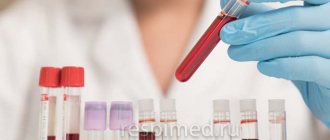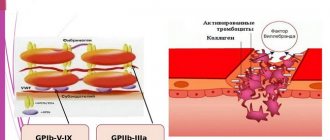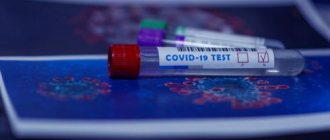A coagulation test or blood clotting test is performed on a child to evaluate whether the blood is able to clot. This analysis is very important, since any deviations from the norm can have serious consequences for the health and life of the baby.
In a child, blood clotting disorders can be congenital or acquired. They can manifest themselves as thickening of the blood and the formation of blood clots or increased bleeding (von Willebrand disease or hemophilia in boys).
Indications for coagulogram
In medical practice, there are cases in which it is necessary to focus on how blood clotting occurs. A blood clotting test is indicated for a child in the following cases:
- before surgery or in the postoperative period
- lists of diseases
- autoimmune diseases
- cardiovascular pathology in a child
- with frequent obvious signs of bleeding, bruises on the skin after minor injuries
- in order to study the causes of damage to the immune defense mechanism
- suspicions of the possibility of developing bleeding disorders
Features of individual interpretation of sample results
Changes in coagulation can be considered normal if they are considered in the context of the current state of the human body. Deviations from average values can be observed in the following cases:
- During pregnancy, the female body prepares for future childbirth, and to prevent blood loss, the coagulation rate increases;
- In older people, the rate of coagulation decreases;
- Patients who come to the doctor in a state of exhaustion show a long blood coagulation time;
Video about blood clotting mechanisms:
Before interpreting the results, the doctor talks with the patient to obtain information about possible factors that explain the accelerated or delayed blood clotting. If there is no such data, then the doctor has reason to suspect pathology and prescribe an additional examination.
How to properly prepare your child for the test
The blood clotting test is taken on an empty stomach, although an exception can be made in this case - allow the child to drink water. Blood is taken for examination from a vein.
A coagulogram is a set of indicators that indicate the coagulation process. Since it is coagulation that has a protective function and ensures normal hemostasis, the second name for such an analysis is hemostasiogram or coagulation hemostasis. But the coagulation system is not the only mechanism that supports the body. Primary hemostasis is ensured by the properties of blood vessels and platelets.
With hypercoagulation (increased clotting), blood clots form during bleeding, but pathology in the form of thromboembolism and thrombosis can develop. When bleeding occurs, hypocoagulation (reduced coagulation) also occurs; it is used in a controlled manner for the treatment of thrombosis.
All those indicators that make up a blood coagulogram can be considered indicative. To make a full assessment, clotting factors must be examined. There are thirteen of them in total, but if at least one of them is insufficient, a person may have serious problems.
Rules for taking a blood test for a coagulogram
At the cost of an erroneous analysis of a coagulogram, vascular thrombosis can occur, in which a disruption of the blood supply to the organ occurs, or, conversely, severe bleeding.
To ensure the reliability of the obtained indicators, blood is collected for a coagulogram only if certain conditions are met:
- Blood sampling is carried out on an empty stomach - the patient should not eat 8-12 hours before; a light dinner is possible the night before. It is strictly forbidden to drink alcoholic beverages, including light ones.
- One hour before the test you should not drink juices, coffee or tea.
- Hard work and intense physical activity are not advisable.
- You can drink a glass of water 15-20 minutes before entering the treatment room.
- If the patient is constantly taking anticoagulants, it is necessary to warn about this in advance.
Minimum set of indicators
A detailed coagulogram includes many indicators. This analysis is used to diagnose many hereditary diseases. Not every medical institution has laboratories that can determine every test, since this requires special equipment.
That is why the analysis in practice includes an optimal set, which, together with indicators of primary hemostasis (bleeding time, number and aggregation of platelets, clot retraction, capillary resistance) allows us to assess the coagulation properties of blood.
What allows us to provide a minimum of information about coagulation? Let us dwell in more detail on common indicators, their norms and deviation options.
Clotting time
Blood in the amount of 2 ml is taken from the cubital vein. Then it is poured in equal quantities into two test tubes, without adding stabilizing substances, and they are placed in a water bath in order to simulate body temperature. The stopwatch immediately starts and the test tubes tilt slightly. The laboratory assistant monitors how the clot forms. The average result obtained over the time of 1 and 2 test tubes is considered reliable.
The normal clotting time is 5-10 minutes. If the clotting time increases to 15 minutes or more, the patient may have a deficiency of the enzyme prothrombinase, vitamin C, fibrinogen and prothrombin. This condition may be an expected consequence of heparin administration, as well as a side effect of contraceptives.
Sometimes you can use a simplified method that uses one test tube, but the result obtained is not as accurate.
Prothrombin time (prothrombin index)
The study is carried out according to the previous scheme, although in this case a standard solution of thromboplastin and calcium chloride is added to the test tube. If thromboplastin is present in sufficient quantities, the blood's ability to clot is tested. Normally, this indicator is 12-20 seconds. If the time extends beyond 20 seconds, this indicates problems in the synthesis of the enzyme prothrombinase, the formation of fibrinogen and prothrombin. This is possible with vitamin deficiency, dysbiosis, malabsorption in the intestines, and liver diseases.
The obtained result is expressed as an index by the percentage ratio of the patient's result to the plasma prothrombin time. This figure in healthy people is 95-105%. If the prothrombin index decreases, this indicates the same pathology as an increase in prothrombin time.
Plasma fibrinogen
The definition of fibrinogen is based on its ability to transform into fibrin as a result of the addition of special agents. Fibrin strands are transferred to the filter, then it is weighed or converted into a colored solution by dissolution. Both one and the other method allow for a quantitative assessment of this indicator. Normally, it is in the range of 2.0-3.5 g/l (5.9-11.7 µmol/l). Fibrinogen can increase with malignant neoplasms, infectious diseases, after surgery, trauma and childbirth, with hypofunction of the thyroid gland, thromboembolism and thrombosis. A decrease in the indicator is possible with fibrinogenemia (congenital diseases), severe liver damage. Fibrinogen in children is lower than in adults. So, in newborns this figure becomes 1.25-3.0 g/l.
The test is carried out for fibrinogen B. It is negative in healthy people.
Activated partial thromboplastin time (aPTT)
Activated partial thromboplastin time is determined as a modification of plasma recalcification with the addition of phospholipids (standard solutions of cephalin or erythrophosphatide). It can be used to detect insufficient coagulation of plasma factors. APTT is the most sensitive indicator of a coagulogram, the norm of which is 38-55 seconds. If the value is shortened, a risk for the development of thrombosis can be suspected; APTT is prolonged with congenital deficiency of clotting factors or treatment with heparin.
Clotting rate
Normally, the first clots become noticeable within 30 seconds from the start of manipulations with the capillary tube. Complete thickening occurs in 3-5 minutes.
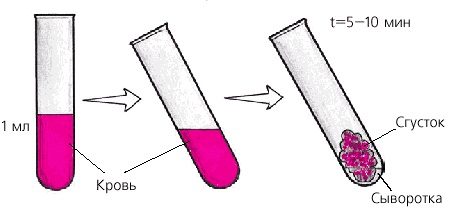
Table of normal results of the coagulation test according to Sukharev
According to Sukharev, the norm for blood clotting in infants is lower (longer) than for adults. In children under one year of age, the liver function to produce fibrinogen is undeveloped, therefore the rate of blood clotting according to Sukharev is reduced. By the age of one year, coagulation indicators in tests are already close to the norm for an adult, but reaches full compliance only by the period of puberty.
Advanced coagulogram indicators
In some cases, to diagnose a particular pathology, it is necessary to determine lesions in the entire blood coagulation system more accurately. For this purpose, additional coagulogram indicators are determined.
Thrombin time
The indicator determines the ability of plasma to clot when a standard solution of active thrombin is added to it. Normally it takes 15-18 seconds. The thrombin time of hereditary fibrinogen deficiency, liver damage, and increased intravascular coagulation increases. Used in treatment with heparin and fibrinolytic drugs.
Blood clot retraction
The method is similar to the previous one, but allows not only to determine the coagulability of the clot, as well as the degree of its compression. The result can be obtained both quantitatively (norm 40-90%) and qualitatively (1 – present, 0 – absent). The indicator increases with anemia of various etiologies, and decreases with thrombocytopenia.
Plasma recalcification time
In a water bath, the plasma is mixed with a solution of calcium chloride in a ratio of 1:2, then the stopwatch is turned on and the time is recorded when a clot appears. This study is repeated three times and the average result is calculated. The normal time for plasma recalcification is 1-2 minutes. The indicator may increase with insufficiency of congenital plasma coagulation factors, thrombocytopenia, and the presence of heparin in the blood. If the time is shortened, this may indicate the hypercoagulable properties of the blood.
Fibrinolytic activity
Using this test, you can assess how much your own blood is able to dissolve blood clots. This indicator depends on the presence of fibrinolysin in plasma. Normally, it ranges from 183 to 263 minutes. A decrease in fibrinolytic activity indicates increased bleeding.
Thrombotest
This analysis is a visual qualitative assessment of the presence of fibrinogen in the blood. The normal thrombotest indicator is grade 4-5.
Reasons for deviations
A deviation in a blood test for coagulation in any direction from the norm indicates a violation of hemostasis and is a reason for an extended examination.
Accelerated blood clotting
The blood clotting time according to Sukharev is reduced as a result of the accelerated formation of coagulation factors (blood prothrombinase) in the patient’s body.
In the body, blood prothrombinase can be replaced by prothrombinase produced when tissue is damaged. Therefore, the acceleration of coagulation can be explained by existing tissue damage (after surgery, burns, vasculitis, tuberculosis) or be a normal condition with regular injuries (in athletes).
Important! High coagulability can be determined in people leading an active lifestyle associated with regular injury (extreme sports, heavy physical labor).
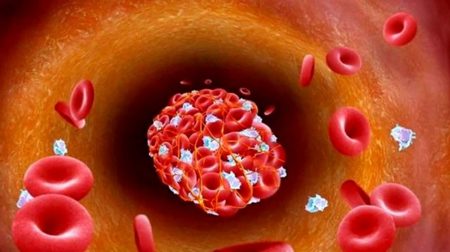
Shortening the clotting time requires prevention, as it threatens the appearance of blood clots, the development of thrombosis and thromboembolism.
Hypercoagulation is determined in the following diseases and conditions of the body:
- Liver pathologies;
- Poisoning;
- Autoimmune diseases;
- Thrombophilia.
In women, clotting may be increased during long-term use of oral contraceptives.
Factors contributing to increased clotting may include:
- Radiation, cancer;
- Hyperfunction of the spleen;
- Dehydration of the body, decreased pH;
- Excessive consumption of sugar, carbohydrates;
- Excess weight, prolonged bed rest, sedentary work;
- Hormone replacement therapy.
Delayed blood clotting
This condition is characterized by prolonged bleeding and occurs as a result of:
- Congenital (hemophilia, von Willebrand disease) or acquired deficiency of factors involved in prothrombin formation (VIII, IX, XI);
- High concentrations of antiplatelet agents, anticoagulants (heparin, acetylsalicylic acid) in the blood;
- Leukemia;
- Thrombocytopenia;
- Impaired production of fibrinogen by the liver in cirrhosis, hepatitis;
- Lack of plasma as a result of acute blood loss with rapid replenishment of blood volume by infusion;
- Low hemoglobin, anemia;
- Lack of calcium, vitamin K.
Important! Slow coagulation in women during pregnancy is dangerous due to severe bleeding during childbirth.
To reduce the duration of coagulation, the patient is prescribed inhibitors of fibrinolysis and clot dissolution (aminocaproic acid, contrical), direct (fibrinogen, thrombin) and indirect (vitamin K, Vicasol) coagulants.
Often such patients are given a transfusion of plasma, which contains a complex of coagulation factors.
